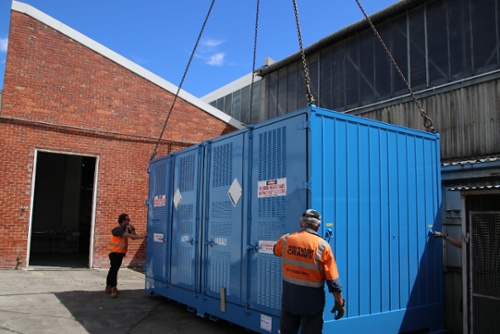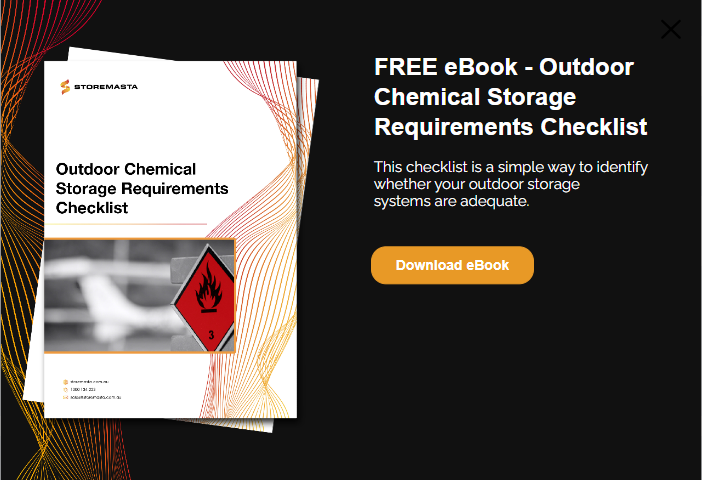While carrying any quantity of dangerous goods poses a range of risks, the complexity of the situation is amplified when you’re keeping chemicals in the outdoor environment. In an outdoor situation, your goods are subject to extreme temperatures and weather conditions, as well as an increased risk of theft, vandalism, misuse or impact damage. You’re also dealing with a situation that often involves larger quantities or bulk quantities of dangerous goods. The larger volume of chemicals alone can create a more challenging situation for the people who are handling and storing these substances. Read our 9 tips for safer outdoor dangerous goods storage to learn how to keep your people, property and environment safe and protected.
1. Know The Risks
So, what risks are associated with outdoor dangerous goods storage?
The outdoor environment, unlike secure and protected indoor locations, can create a range of unique risk factors.
When determining your outdoor DG storage needs, it’s vital that you consider these specific outdoor conditions. These considerations may include the possibility of:
- Natural disasters – events such as floods and bushfires can create catastrophic situations for businesses that hold chemicals in outdoor stores.
- Weather conditions – such as extreme heat or cold, snow, lightning storms, strong winds or dust storms.
- Falling or airborne debris – due to the outdoor environment, there is the risk of your chemical stores being damaged or impacted by debris such as tree branches.
- Impact damage - from equipment and vehicles.
- Theft and vandalism – while your hazardous substances may be stored in a locked safety cabinet within a secured indoor workplace, your outdoor stores are subject to a wider range of security risks which must be controlled.
In addition to choosing an outdoor chemical store that protects your substances from these factors, you should also give careful consideration to the location and environment in which you’re keeping your dangerous goods. You will also have to ensure that your dangerous goods storage facility is installed away from protected and public places, to minimise risk to your community.
Implementing added security measures, such as CCTV and a locked fence, can provide further protection against theft and vandalism. Selecting a location for your store that is protected from falling branches or other debris, can assist with keeping your chemicals packages safe and stable.
If you are in a location that is prone to natural disasters, make sure that your store is located above the previous highest flood level, so your store won’t be subject to damage during heavy rains. If there is extreme heat and sunlight within your outdoor environment, consider installing a parasol roof to protect your dangerous goods store from the elements.
IMPORTANT: If you’re located in a cyclone-prone location, enquire about the added protection of a higher cyclone rating. While Storemasta Outdoor Chemical Stores are manufactured with a cyclone-proof construction, certain regions may require added cyclone protection.
2. Understand Your Dangerous Goods Class
Each class of dangerous goods has its own unique set of chemical hazards. These hazards must be addressed with the correct storage and handling practices. However, there are some general chemical risks that apply to each DG class.
Class 3 Flammable Liquids must be stored in an outdoor environment that reduces the risk of ignition, including spill containment, natural ventilation and the appropriate diamond and hazard signage.
Some key risks for dangerous goods classes may include:
- Class 3 Flammable Liquids – fire, explosion, chemical burns, asphyxiation
- Class 4 Flammable Solids – fire, explosion, asphyxiation, human harm
- Division 5.1 Oxidizing Agents – asphyxiation, human harm, chemical reactions, fire
- Division 5.2 Organic Peroxides – fire, explosion, human harm, asphyxiation, property damage, chemical reactions
- Division 6.1 Toxic Substances – poisening of people, animals and wildlife, asphyxiation, environmental contamination
- Class 8 Corrosive Substances – human harm, property damage, environmental contamination
IMPORTANT: When you’re determining your outdoor chemical storage requirements, always refer to the relevant Australian Standard for the particular class of dangerous goods that you’re storing. The Standard will detail all the handling and storage requirements for your hazardous chemical and provide the specific control measures that are needed to minimise risk.
3. Refer to the Regulations and Standards
To comply with WHS Regulations and Australian Standards, any organisation or business that holds hazardous chemicals must eliminate or reduce the hazard. While WHS Regulations provide an overview of your compliance obligations, the Australian Standards offers highly detailed information that can provide a step-by-step guide to minimising chemical risk.
These Standards detail the in-depth requirements that relate to the handling and storage of that particular dangerous goods class. This may include the requirements for the construction of your store, as well as its location, usage and maintenance. Each Standard offers highly specific requirements that are necessary for the control of the risks associated with that chemical class.
However, due to the complexity of these requirements, many organisations opt for ready-made storage solutions — such as chemical storage containers or dangerous goods containers — instead of custom solutions that are built onsite.

Relocatable outdoor DG storage can provide a convenient, cost-effective and compliant choice.
These dangerous goods storage solutions are recognised as a more convenient and cost-effective storage option. They can also be quickly and easily relocated if your business moves to another location, or your workplace configuration needs to change.
REMEMBER: It’s not enough to simply select a compliant chemical store. Instructions on how to install, use, inspect and maintain your store is also set out in the applicable Australian Standard.
4. Conduct a Risk Assessment
While understanding your obligations under WHS Regulations and the Australian Standards is essential, it’s also crucial that you conduct a risk assessment of your site.
An onsite risk assessment should be conducted by inhouse personnel with sufficient knowledge of chemical safety and compliance. Alternatively, you should engage a Dangerous Goods Consultant to provide a risk assessment if your team don’t possess these skills.

Conduct a risk assessment prior to purchasing your dangerous goods storage equipment, so you can adequately minimise any chemical hazards.
Your risk assessment will determine the exact level of risk that you face, as well as provide the framework for determining the controls that are needed to minimise harm to people, property and the environment.
IMPORTANT: If you introduce new work practices, chemicals or dangerous goods stores to your site, you will have to conduct a further risk assessment to ensure that no new hazards have been created.
5. Compliant Construction
Compliant containers, regardless of their type, will be constructed in full conformance with Australian Standards. This means that a compliant chemical storage container will feature a range of risk control measures that will specifically reduce the risks associated with the dangerous goods class of the chemicals that you’re storing.
IMPORTANT: Always ensure that the chemical storage container you’re using meets all the requirements of the relevant Australian Standard. You can find this information through your container manufacturer or chemical storage supplier.
The engineering controls of the relocatable containers should include:
- Chemically resistant construction materials
- Chemical spill containment
- Natural ventilation system
- Impact protection
- Secure and designated storage space
We’ll go into further details about these risk control features in more detail below.
6. Containment for Leaks and Spillage
One of the biggest issues with outdoor storage is the risk that the chemicals will leak or spill into the natural environment. Chemicals can quickly seep into outdoor flooring, soil, drains and water supplies in the event of a chemical spill.
Like to learn more about spill containment?
Not only do spills pose a risk to the environment, but they may increase the likelihood of:
- Fire or explosion, if the liquids are flammable or combustible
- Harmful vapour emissions
- Chemical reactions with incompatible substances or materials
- Skin and eye irritation if spillage comes into contact with staff
- Asphyxiation, poisoning and other harmful health effects if staff are exposed to the spill
All compliant chemical storage containers are equipped with a liquid-tight spill containment sump that meets the capacity requirements of the Australian Standards.
However, when storing your chemicals in any type of storage container, it’s crucial that spills and leaks are monitored, reported and cleaned-up as quickly as possible. Spill containment sumps are only designed to catch the spill – not keep it for hours or days on end. So, make sure your team have procedures and training in place that ensures the spill bunds are monitored and cleaned out as soon as leaks or spills occur.

Ensure that your spill containment bund is regularly inspected and cleaned out to maintain safety and compliance.
7. Natural Ventilation
As many classes of dangerous goods emit large quantities of hazardous vapours, it’s important that your outdoor DG storage is equipped with natural ventilation.
Storage containers may have a build-up of hazardous vapours and gases, which can overwhelm workers — causing both acute and chronic health effects. Therefore, to remain compliant and keep your vapour levels within the legal limits (as set by the workplace exposure standards), you should always keep your storage containers clean, organised and free from leaks, spills and residue.
In addition to practicing good housekeeping procedures, you must also have a ventilation system to aid the dispersion of hazardous vapours. Compliant chemical storage containers are equipped with at least two walls of louvres, which helps move the air around inside the container and disperse hazardous vapours to the outdoor area.
However, make sure that your chemical storage container is not located close to protected places, public places or other areas where people may tend to congregate, as vapour emissions may impact on staff and the community.
8. Protection from Impact
Dangerous goods containers and chemical storage containers are all constructed to provide protection for the chemical packages that they’re storing. Walls are manufactured with durable sheet steel, and heavy-duty shelving assists with protecting the packages from toppling or falling.
The chemical containers that are kept within a storage facility should never be stacked, loaded or handled in such a way that allows for the dropping or damaging of the chemical container. Make sure that any IBCs, drums or heavy containers are transferred to and from your outdoor DG storage site with the appropriate transfer equipment, to avoid accidents and spillage.
9. Security and Signage
Any outdoor DG storage facility must be equipped with adequate security measures to prevent vandalism, theft and misuse. Therefore, compliant chemical storage containers are manufactured with ISO locking bars to ensure a high level of security.
To create a safer working environment and meet your compliance obligations, you must also ensure that your outdoor DG store is equipped with the applicable dangerous goods diamond and hazard signage. This is to alert any personnel in the outdoor area to the hazards associated with your chemical store.
Are You Meeting the Outdoor Chemical Storage Requirements?
As we’ve highlighted in this blog, there are specific considerations your business will have to make when considering outdoor dangerous goods storage. Risks such as fire, explosion, hazardous vapours and environmental contamination can all be controlled through the selection, installation and maintenance of a compliant chemical storage container.
To learn more about controlling the risks associated with outdoor dangerous goods storage, why not download our helpful checklist? Outdoor Chemical Storage Requirements Checklist will help you determine your dangerous goods storage needs and reduce chemical risk for your business. Get a copy of your free checklist today by clicking on the image below.

Living life by the 4 C’s of marketing – communication, coffee, compliance… and more coffee – Leisa Andersen is Storemasta’s Content Marketing Manager. When she’s not writing, you’ll find her enjoying all the good things in life, including shopping, travel and gluten free donuts.

